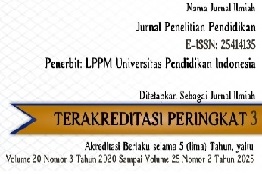Exploring the Local Language Students’ Foreign Language Anxiety in EFL Online Class: Students’ Genders and Speaking Performance
Abstract
Keywords
Full Text:
PDFReferences
Abrar, M., Failasofah, Fajaryani, N., & Masbirorotni. (2016). EFL student teachers’ speaking anxiety: the case in one English teacher education program. IJEE (Indonesian Journal of English Education), 3(1), 60-75. https://doi.org/http://dx.doi.org/10.15408/ijee.v3i1.3619
Aguila, K. B., & Harjanto, I. (2016). Foreign language anxiety and its impacts on students’ speaking competency. Anima Indonesian Psychological Journal, 32(1), 29-40. https://doi.org/https://doi.org/10.24123/aipj.v32i1.582
Awan, R. N., Azher, M., Anwar, M. N., & Naz, A. (2010). An investigation of foreign language classroom anxiety and its relationship with students' achievement. Journal of College Teaching & Learning, 7(11), 33-40. From https://eric.ed.gov/?id=EJ906750
Bekleyen, N. (2004). The Influence of teachers and peers on foreign language classroom anxiety. Dil Dergisi, 123, 49-66. https://doi.org/https://doi.org/10.1501/Dilder_0000000005
Cheng, Y., Horwitz, E. K., & Schallert, D. L. (1999). Language anxiety: Differentiating writing and speaking components. Language Learning, 49(3), 417-446. https://doi.org/https://doi.org/10.1111/0023-8333.00095
Dewaele, J. M., MacIntyre, P., Boudreau, C., & Dewaele, L. (2016). Do girls have all the fun? Anxiety and enjoyment in the foreign language classroom. Theory and Practice of Second Language Acquisition, 2(1), 41-63. https://doi.org/https://journals.us.edu.pl/index.php/TAPSLA/article/view/3941
Erdiana, N., Daud, B., Sari, D. F., & Dwitami, S. K. (2020). A study of anxiety experienced by EFL students in speaking performance. Studies in English Language and Education, 7(2), 334-346. https://doi.org/https://doi.org/10.24815/siele.v7i2.16768
Farokhipour, S., Khoshsima, H., & Sarani, A. G. (2018). A dynamic intervention for removing learning anxiety: A field experiment on removing psychological barriers to speaking. International Journal Behavioral Science, 12(1), 25-31. https://doi.org/http://www.behavsci.ir/article_81286.html
Galante, A. (2018). Drama for L2 speaking and language anxiety: Evidence from Brazilian EFL learners. RELC Journal, 49(3), 273-289. https://doi.org/https://doi.org/10.1177/0033688217746205
Gerencheal, B. (2016). Gender Differences in foreign language anxiety at an Ethiopian university: Mizan-Tepi University third year English major students in focus. African Journal of Education and Practice, 1(1), 1-16. https://doi.org/https://files.eric.ed.gov/fulltext/ED582461.pdf
Goh, C. C., & Burns, A. (2012). Teaching speaking: A holistic approach. Cambridge University Press.
Horverak, M. O., Langeland, G. M., Løvik, A., Askland, S., Scheffler, P., & Wach, A. (2022). Systematic work with speaking skills and motivation in second language classes. IAFOR Journal of Education, 10(1). https://doi.org/https://doi.org/10.22492/ije.10.1.02
Horwitz, E. K. (2001). Language anxiety and achievement. Annual Review of Applied Linguistics, 21, 112-126. https://doi.org/https://doi.org/10.1017/S0267190501000071
Horwitz, E. K., Horwitz, M. B., & Cope, J. (1986). Foreign language classroom anxiety. The Modern Language Journal, 70(2), 125-132. https://doi.org/https://doi.org/10.2307/327317
Kim, S.-Y. (2009). Questioning the stability of foreign language classroom anxiety and motivation across different classroom contexts. Foreign Language Annals, 42(1), 138-157. https://doi.org/https://doi.org/10.1111/j.1944-9720.2009.01012.x
Krashen, S. D. (1982). Principles and practice in second language acquisition. Pergamon Press Inc.
MacIntyre, P. D. (1995). How Does Anxiety Affect Second Language Learning? A Reply to Sparks and Ganschow. The Modern Language Journal, 79(1), 90-99. https://doi.org/http://www.jstor.org/stable/329395
Matsuda, S., & Gobel, P. (2004). Anxiety and predictors of performance in the foreign language classroom. System, 32(1), 21-36. https://doi.org/https://doi.org/10.1016/j.system.2003.08.002
Mouhoubi-Messadh, C., & Khaldi, K. (2022). Dealing with foreign language speaking anxiety: What every language teacher should know. Training, Language and Culture, 6(1), 20-32. https://doi.org/https://doi.org/10.22363/2521-442X-2022-6-1-20-32
Ningsih, L. R., & Fatimah, S. (2020). An analysis of speaking anxiety experienced by tourism and hospitality department students of SMKN 6 Padang. Journal of English Language Teaching, 9(1), 241-251. https://doi.org/http://ejournal.unp.ac.id/index.php/jelt/article/view/108174
Nugroho, I., Miftakh, F., & Wahyuna, T. W. (2021). Exploring students’ speaking anxiety factors in an online EFL classroom. INTERACTION: Jurnal Pendidikan Bahasa, 8(2), 228-239. https://doi.org/https://doi.org/10.36232/jurnalpendidikanbahasa.v8i2.1337
Öztürk, G., & Gürbüz, N. (2013). The impact of gender on foreign language speaking anxiety and motivation. Procedia - Social and Behavioral Sciences, 70, 654-665. https://doi.org/https://doi.org/10.1016/j.sbspro.2013.01.106
Piniel, K., & Zólyomi, A. (2022). Gender differences in foreign language classroom anxiety: Results of a meta-analysis. Studies in Second Language Learning and Teaching, 12(2), 173-203. https://doi.org/http://dx.doi.org/10.14746/ssllt.2022.12.2.2
Richards, J. C. (2008). Teaching listening and speaking from theory to practice. Cambridge University Press.
Sahid, S., Aldiansyah, & Iskandar. (2018). Understanding gender differences in students’ anxiety in seminar presentation. International Journal of Humanities and Innovation, 1(1), 35-46. From https://osf.io/b6x8n/download
Sparks, R. L., & Ganschow, L. (2007). Is the foreign language classroom anxiety scale measuring anxiety or language skills? Foreign Language Annals, 40(2), 260-287. https://doi.org/https://doi.org/10.1111/j.1944-9720.2007.tb03201.x
Wienanda, W. K., & Widiati, U. (2017). Students' gender, anxiety, and speaking performance in the Indonesian EFL context. Jurnal Ilmu Pendidikan, 23(1), 60-71. https://doi.org/http://dx.doi.org/10.17977/jip.v23i1.10758
DOI: https://doi.org/10.17509/jpp.v22i2.53722
Refbacks
- There are currently no refbacks.
Copyright (c) 2022 Jurnal Penelitian Pendidikan


